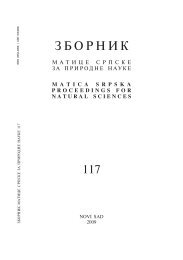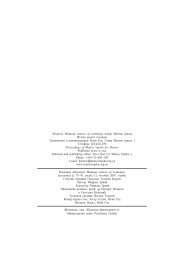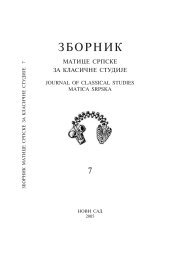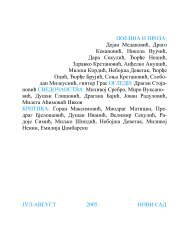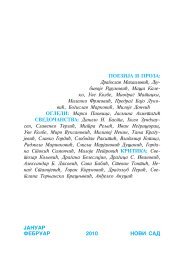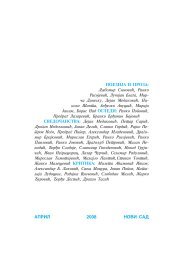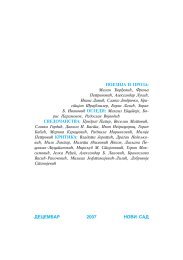You also want an ePaper? Increase the reach of your titles
YUMPU automatically turns print PDFs into web optimized ePapers that Google loves.
of the central Balkans or across northern Anatolia. See Patrick E. McGovern, Ancient<br />
Wine. The Search for the Origins of Viticulture (Princeton and Oxford 2007).<br />
6 Nestor's generous reception of Telemachus and “Mentor" in Book 3(34—<br />
370)113—318) is a concrete instance — as is the young prince's welcome of<br />
“Mentes" in Book 1!<br />
7 These include the well-known kylix by Exekias in Munich (M2044; Beazley<br />
Archive 310403) that depicts the god alone on a ship — the pirate ship?<br />
8 Laurels appear in “Homeric" epic only at Od. 9.183, hanging over the entrance<br />
to Polyphemus' cave, in a land that abounds in untilled grain fields and wild<br />
grapevines (9.110—111 and 357—358). The rain of Zeus makes them flourish (111<br />
and 358). For oracular laurel stands below Parnassus see Hymn 3, ll. 395—396.<br />
9 Here ñlaìai is a lectio difficilis, to which a “correction" Ñtaìrai has<br />
occasionally been preferred (e.g., in Ebeling's 1885 Lexicon Homericum, there understood<br />
to refer to nymphs). However, the later parallel statement, also rather<br />
unexpected, that not one of the birds gave Demeter any news of her daughter (line<br />
45; see the formulaic lines that precede, 22 and 44) suggests that trees rather than<br />
anthropomorphic nymphs are likelier for line 23.<br />
10 The Homeric Hymn to Demeter (Oxford 1974), pp. 154—155. He compares<br />
the non-barking dogs in Hymn No. 4 to Hermes, ll. 143—145, where gods and<br />
mortals are likewise mentioned. Dogs, however, are regularly associated with that<br />
god, whereas olive “belongs" to Athena and the significant bird to Zeus, Apollo,<br />
and (in the Odyssey) Athena.<br />
11 Furthermore, Odysseus uses some poplar timber for the substantial raft he<br />
makes to sail from Calypso's island (5.238—240), using Athena's shipwright skill<br />
and an axe with a handle of her olive-wood.<br />
12 In the Doloneia Athena takes the form of a heron (ñrwdiÃj), “heron", a<br />
species named only here in epic (Il. 10.174—276), which Odysseus and Diomedes<br />
do not see in the dark of night, only hear its cry as a sign of her presence and support.<br />
This, like the rest of this incongruous book, seems more Odyssean than Iliadic.<br />
13 On the distinctively Athenian features and overall character of the Odyssey,<br />
see Erwin Cook, The Odyssey in Athens. Myths of Cultural Origins (Cornell University<br />
Press 1995).<br />
14 Other Olympian goddesses in this broad category, though mourners, are<br />
not prototypical mournful mothers. Aphrodite is not the mother of Adonis, nor Artemis<br />
of Hippolytus. Both do have similar wild animal associations, Artemis generally,<br />
Aphrodite in Hymn No. 5 (l. 70—71: wolves and lions, bears and panthers).<br />
Semele's son Dionysus, as we see in Hymn No. 7, has power to manifest bear and<br />
lion. 15 Dreams and sleep may be thought to be more Hermes' than Apollo's province.<br />
In fact, in Odyssey, Athena sends sleep (1.363—364, 5.492—494, 16.450—<br />
451, 19.603—604 20.55) and dreams (4.795—839 and probably the one Penelope<br />
recounts in Book 19) — a typical instance of how several Olympians' energies<br />
converge in the cause of Odysseus and Penelope.<br />
16 The exceptions are in the exordium to the Iliad's Catalogue of Ships (Il.<br />
2.484—493), which seems to belong to the same Boeotian tradition as the Theogony<br />
of Hesiod, claiming a bevy of non-deceptive patronesses where multiple Muses<br />
seem to guarantee not variety in art but consensus and truth.<br />
17 We can only guess how horses and chariots figured in the episodes of the<br />
Aethiopis introducing, magnifying, and eliminating Penthesileia. When Achilles<br />
finally catches and kills her she seems, from Exekias' and other painters' representations,<br />
to have been unhorsed.<br />
62





